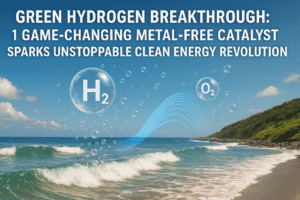Green Hydrogen Breakthrough: 1 Game-Changing Metal-Free Catalyst Sparks Unstoppable Clean Energy Revolution
Scientists at Jawaharlal Nehru Centre for Advanced Scientific Research (JNCASR) have pioneered a cost-effective, metal-free catalyst that generates hydrogen fuel by converting mechanical energy into chemical reactions. Using a porous organic framework (COF) built from donor-acceptor molecules, the innovation eliminates reliance on rare metals while achieving exceptional efficiency. The COF’s unique ferrielectric ordering creates internal electric fields under mechanical stress, splitting water into hydrogen and oxygen.
This approach outperforms traditional metal-based piezocatalysts, offering higher hydrogen yields and leveraging ambient energy sources like vibrations or waves. The design’s simplicity, scalability, and alignment with India’s National Green Hydrogen Mission position it as a transformative tool for sustainable energy. By reimagining catalysis through organic chemistry, this breakthrough accelerates the shift toward decarbonization, proving that clean hydrogen production can be both affordable and eco-friendly.

Green Hydrogen Breakthrough: 1 Game-Changing Metal-Free Catalyst Sparks Unstoppable Clean Energy Revolution
In a landmark advancement for sustainable energy, scientists at Jawaharlal Nehru Centre for Advanced Scientific Research (JNCASR) have unveiled a novel metal-free catalyst that harnesses mechanical energy to produce hydrogen fuel—a critical step toward reducing reliance on fossil fuels. This innovation aligns with India’s ambitious National Green Hydrogen Mission, aiming to position the country as a global leader in clean hydrogen technology.
The Catalyst: Simplicity Meets Efficiency
The team, led by Professor Tapas K. Maji, designed a porous covalent organic framework (COF) using two organic molecules: a donor (TAPA) and an acceptor (PDA). Unlike traditional catalysts reliant on rare or expensive metals, this COF leverages a unique ferrielectric (FiE) ordering—a property that creates strong internal electric fields when mechanical stress is applied. This structure allows water molecules to penetrate its sponge-like pores, where mechanical energy (like vibrations or pressure) triggers charge separation, splitting water into hydrogen and oxygen.
Why This Matters
- Metal-Free & Cost-Effective: Eliminating metals like platinum or titanium reduces costs and environmental impact, making green hydrogen more accessible.
- Harnessing Mechanical Energy: Traditional electrolysis requires electricity, often from non-renewable sources. Piezocatalysis converts ambient mechanical energy (e.g., ocean waves, industrial vibrations) directly into fuel.
- Unmatched Efficiency: The COF’s FiE ordering generates more surface charges than conventional ferroelectric materials, achieving higher hydrogen yields—outperforming metal-based counterparts.
The Science Behind the Innovation
The COF’s propeller-shaped TAPA units create structural instability, enabling dynamic molecular motion. When pressure is applied, this motion amplifies charge separation. Theoretical modeling by collaborators at JNCASR and IISER Pune revealed that the COF’s electronic bands interact resonantly, sustaining FiE ordering. This synergy between structure and function ensures sustained catalytic activity without performance decay.
Broader Implications
This discovery challenges the long-held assumption that heavy metals are essential for catalysis. By demonstrating the viability of organic materials, the research opens doors to designing eco-friendly catalysts for other reactions, such as CO₂ reduction or ammonia synthesis.
Path to Real-World Impact
Scalability remains a key focus. The COF’s simplicity—built from readily available organic components—suggests potential for large-scale manufacturing. Integrating these catalysts into environments rich in mechanical energy (e.g., coastal areas with wave energy or industrial zones with machinery vibrations) could decentralize hydrogen production, empowering communities with clean fuel generation.
A Collaborative Triumph
The interdisciplinary effort included computational experts, material scientists, and international collaborators, underscoring the power of global cooperation in tackling climate challenges. As Prof. Maji notes, “This isn’t just a lab breakthrough—it’s a blueprint for sustainable innovation.”
Looking Ahead
While challenges like optimizing mechanical energy harvesting systems persist, this metal-free catalyst marks a paradigm shift. As India and the world strive for net-zero emissions, such innovations could accelerate the transition to a hydrogen-powered future—where clean energy is not just viable but inevitable.
In a world increasingly desperate for climate solutions, this research proves that sometimes, the most revolutionary answers lie not in complex metals, but in the elegant design of organic chemistry.
You must be logged in to post a comment.